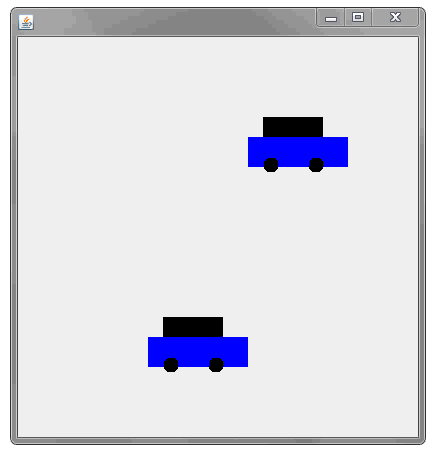Drawing Multiple JComponents to a Frame
What you want to do is use a data structure of Car objects and loop through them in the paintComonent method. Something like
List<Car> cars = new ArrayList<>();
....
@Override
protected void paintComponent(Graphics g) {
super.paintComponent(g);
for (Car car : cars) {
car.drawCar(g);
}
}
The drawCar method would come from your Car class
public class Car {
int x, y;
public Car(int x, int y) {
this.x = x;
this.y = y;
}
public void drawCar(Graphics g) {
g.setColor(Color.BLACK);
// do everything here as you would in a paintComponent method
}
}
See more examples here and here and here and here and here and here.
UPDATE
Here is a simple example use some "Ferraris" I whipped up, also using some animation, but with the same basic points I have above.

import java.awt.Color;
import java.awt.Dimension;
import java.awt.Graphics;
import java.awt.event.ActionEvent;
import java.awt.event.ActionListener;
import java.util.ArrayList;
import java.util.List;
import javax.swing.JFrame;
import javax.swing.JPanel;
import javax.swing.SwingUtilities;
import javax.swing.Timer;
public class DrawCar extends JPanel{
private static final int D_W = 400;
private static final int D_H = 400;
List<Car> cars;
public DrawCar() {
cars = new ArrayList<>();
cars.add(new Car(100, 300));
cars.add(new Car(200, 100));
Timer timer = new Timer(50, new ActionListener(){
public void actionPerformed(ActionEvent e) {
for (Car car : cars) {
car.move();
repaint();
}
}
});
timer.start();
}
@Override
protected void paintComponent(Graphics g) {
super.paintComponent(g);
for (Car car : cars) {
car.drawCar(g);
}
}
@Override
public Dimension getPreferredSize() {
return new Dimension(D_W, D_H);
}
public class Car {
private static final int INCREMENT = 5;
int x, y;
public Car(int x, int y) {
this.x = x;
this.y = y;
}
public void drawCar(Graphics g) {
g.setColor(Color.BLUE);
g.fillRect(x, y, 100, 30);
g.setColor(Color.BLACK); // body
g.fillOval(x + 15, y + 20, 15, 15); // wheel
g.fillOval(x + 60, y + 20, 15, 15); // wheel
g.fillRect(x + 15, y - 20, 60, 20); // top
}
public void move() {
if (x == D_W) {
x = 0;
} else {
x += INCREMENT;
}
}
}
public static void main(String[] args) {
SwingUtilities.invokeLater(new Runnable() {
public void run() {
JFrame frame = new JFrame();
frame.add(new DrawCar());
frame.setDefaultCloseOperation(JFrame.EXIT_ON_CLOSE);
frame.pack();
frame.setLocationRelativeTo(null);
frame.setVisible(true);
}
});
}
}
but it appears that they are overwriting each other.
The default layout manager for a JFrame is a BorderLayout. So by default you are adding all your components to the CENTER of the BorderLayout. However, you can only ever add one component to the CENTER so only the last Car is displayed.
Change the Layout Manager to a FlowLayout to see the difference.
Or, it looks like you are trying to paint the Cars in random positions, in which case you should use a "null" layout. Then you will be responsible for setting the size/location of each of the Car components.